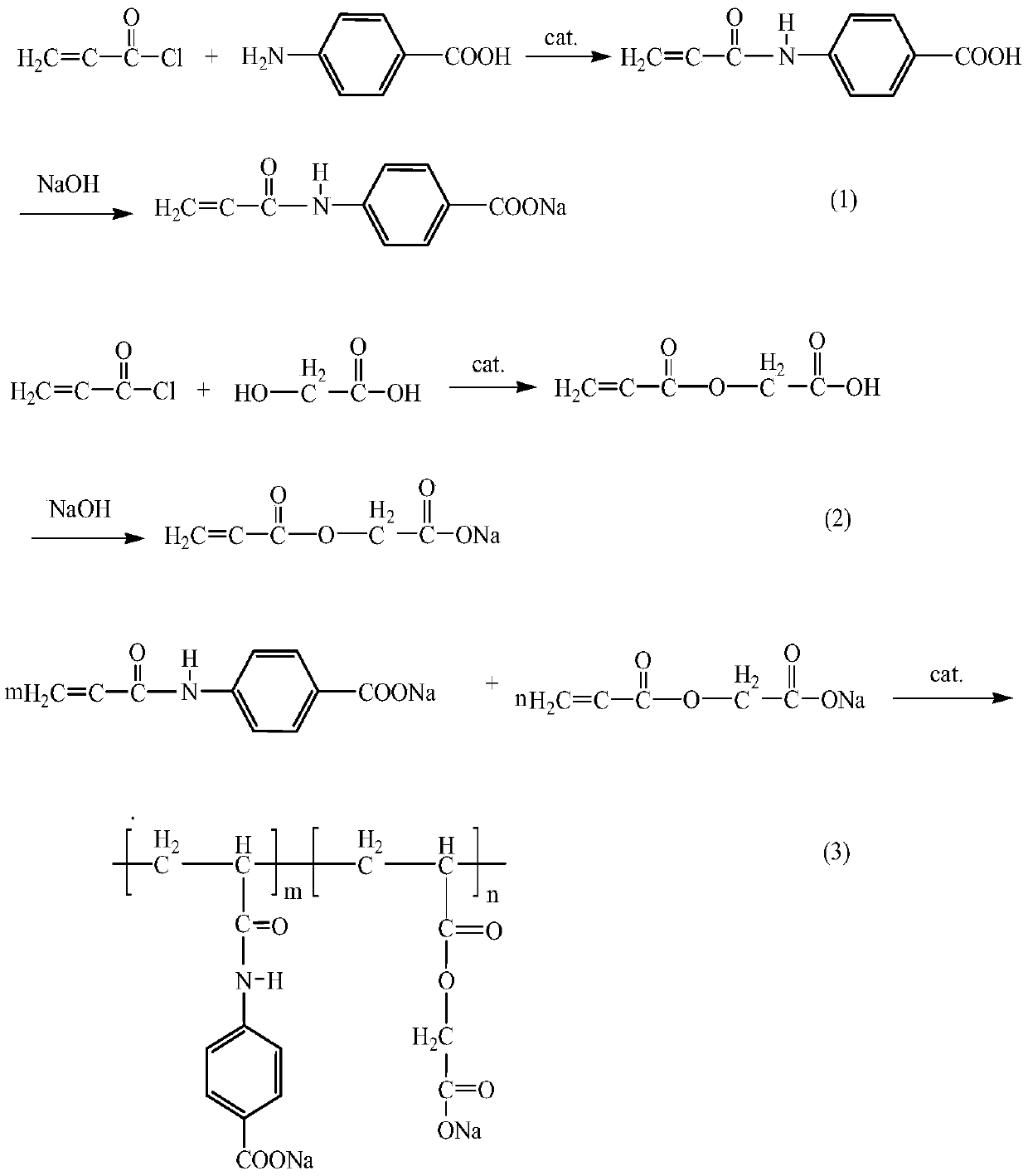Anionic high-polymer flocculant and preparation method thereof
An anionic polymer and flocculant technology, applied in the direction of flocculation/sedimentation water/sewage treatment, etc., can solve the problems of poor salt tolerance and limitations, and achieve the effect of good salt tolerance, wide pH range, and enlarged size
- Summary
- Abstract
- Description
- Claims
- Application Information
AI Technical Summary
Problems solved by technology
Method used
Image
Examples
Embodiment 1
[0044] (1) Add p-aminobenzoic acid to the solvent ethyl acetate and add acid-binding agent triethylamine, stir to fully dissolve p-aminobenzoic acid and heat up to 30°C, then slowly add acryloyl chloride dropwise for 15 minutes After the dropwise addition, the temperature was raised to 45°C, condensed and refluxed for constant temperature reaction for 2 hours, and a mixture of p-acrylamide benzoic acid and triethylamine hydrochloride was obtained; wherein, the mass ratio of p-aminobenzoic acid, acryloyl chloride and triethylamine It is 1:1:0.5.
[0045] (2) The mixture of p-acrylamide benzoic acid and triethylamine hydrochloride prepared in step (1) was washed twice with deionized water at room temperature, and the crude product of p-acrylamide benzoic acid was obtained by suction filtration, which was purely crystallized with ethanol The pure product of p-acrylamide benzoic acid was obtained.
[0046] (3) obtain the aqueous solution of sodium p-acrylamide benzoate with the p...
Embodiment 2
[0052] (1) Add p-aminobenzoic acid to the solvent ethyl acetate and add the acid-binding agent triethylamine, stir to fully dissolve the p-aminobenzoic acid and raise the temperature to 40°C, and slowly add acryloyl chloride dropwise for 25 minutes After the dropwise addition, the temperature was raised to 45°C, condensed and refluxed for constant temperature reaction for 1.5h, and a mixture of p-acrylamide benzoic acid and triethylamine hydrochloride was obtained; wherein, the amount of p-aminobenzoic acid, acryloyl chloride and triethylamine The ratio is 1:1.2:0.7.
[0053] (2) The mixture of p-acrylamide benzoic acid and triethylamine hydrochloride prepared in step (1) was washed twice with deionized water at room temperature, and the crude product of p-acrylamide benzoic acid was obtained by suction filtration, which was purely crystallized with ethanol The pure product of p-acrylamide benzoic acid was obtained.
[0054] (3) obtain the aqueous solution of sodium p-acrylam...
Embodiment 3
[0060] (1) Add p-aminobenzoic acid to the solvent ethyl acetate and add acid-binding agent sodium hydroxide, stir to fully dissolve p-aminobenzoic acid and heat up to 45°C, and slowly add acryloyl chloride dropwise for 30 minutes , after the dropwise addition, the temperature was raised to 50°C, condensed and refluxed for constant temperature reaction for 1 hour, and a mixture of p-acrylamide benzoic acid and triethylamine hydrochloride was obtained; wherein, the mass ratio of p-aminobenzoic acid, acryloyl chloride and triethylamine It is 1:1.2:0.9.
[0061] (2) The mixture of p-acrylamide benzoic acid and triethylamine hydrochloride prepared in step (1) was washed 3 times with deionized water at room temperature, and the crude product of p-acrylamide benzoic acid was obtained by suction filtration, which was purely crystallized with ethanol The pure product of p-acrylamide benzoic acid was obtained.
[0062] (3) obtain the aqueous solution of sodium p-acrylamide benzoate wit...
PUM
| Property | Measurement | Unit |
|---|---|---|
| quality score | aaaaa | aaaaa |
Abstract
Description
Claims
Application Information
 Login to View More
Login to View More - R&D
- Intellectual Property
- Life Sciences
- Materials
- Tech Scout
- Unparalleled Data Quality
- Higher Quality Content
- 60% Fewer Hallucinations
Browse by: Latest US Patents, China's latest patents, Technical Efficacy Thesaurus, Application Domain, Technology Topic, Popular Technical Reports.
© 2025 PatSnap. All rights reserved.Legal|Privacy policy|Modern Slavery Act Transparency Statement|Sitemap|About US| Contact US: help@patsnap.com



